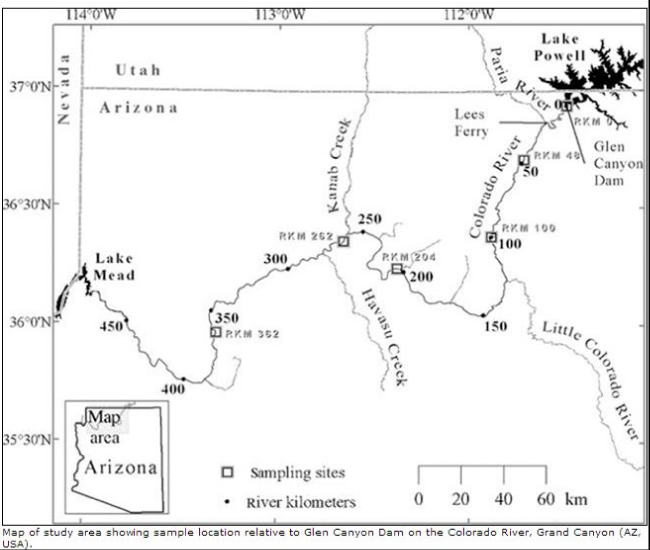
A study conducted by the U.S. Geological Survey (USGS) claims to have found “relatively high” concentrations of mercury (Hg) and selenium (Se) in the food web along the Colorado River between Glen Canyon Dam and the Grand Canyon, “compared with other large rivers.” The study was done in the summer of 2008, but curiously, results were just published in the journal Environmental Toxicology and Chemistry in August 2015. Perhaps they were taking advantage of publicity associated with the toxic spill from the Gold King mine in Colorado earlier this month.
The study is pay-walled, but you can read a USGS press release here.
Some excerpts from the press release:
“The study, led by the U.S. Geological Survey, found that concentrations of mercury and selenium in Colorado River food webs of the Grand Canyon National Park, regularly exceeded risk thresholds for fish and wildlife. These risk thresholds indicate the concentrations of toxins in food that could be harmful if eaten by fish, wildlife and humans. These findings add to a growing body of research demonstrating that remote ecosystems are vulnerable to long-range transport and bioaccumulation of contaminants.”
“The study examined food webs at six sites along nearly 250 miles of the Colorado River downstream from Glen Canyon Dam within Glen Canyon National Recreation Area and Grand Canyon National Park in the summer of 2008. The researchers found that mercury and selenium concentrations in minnows and invertebrates exceeded dietary fish and wildlife toxicity thresholds.” “Although the number of samples was relatively low, mercury levels in rainbow trout, the most common species harvested by anglers in the study area, were below the EPA threshold that would trigger advisories for human consumption.”
“Although the number of samples was relatively low, mercury levels in rainbow trout, the most common species harvested by anglers in the study area, were below the EPA threshold that would trigger advisories for human consumption.”
As far as I can determine from material that was not pay-walled, the study analyzed fewer than 25 samples along 250 miles of river. That is indeed a very low number upon which to form conclusions.
“The good news is that concentrations of mercury in rainbow trout were very low in the popular Glen Canyon sport fishery, and all of the large rainbow trout analyzed from the Grand Canyon were also well below the risk thresholds for humans,” said one of the study authors.
“We also found some surprising patterns of mercury in rainbow trout in the Grand Canyon. Biomagnification usually leads to large fish having higher concentrations of mercury than small fish. But we found the opposite pattern, where small, 3-inch rainbow trout in the Grand Canyon had higher concentrations than the larger rainbow trout that anglers target.”
Regarding mercury: “Airborne transport and deposition — with much of it coming from outside the country — is most commonly identified as the mechanism for contaminant introduction to remote ecosystems, and this is a potential pathway for mercury entering the Grand Canyon food web.” Selenium is derived from “irrigation of selenium-rich soils in the upper Colorado River basin contributes much of the selenium that is present in the Colorado River in Grand Canyon.”
The paper abstract notes that “consistent longitudinal patterns in Hg or Se concentrations relative to the dam were lacking.” That would seem to cast in doubt the proposed source of selenium from upstream irrigation of agricultural land. The “relatively high” concentrations they were talking about in fish are 0.17–1.59 ppm Hg and 1.35–2.65 ppm Se.
